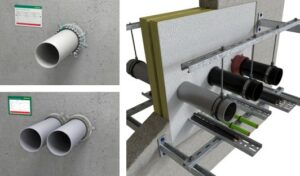 A critical factor that affects what firestop solutions can be used is the number and type of services that pass through a single opening. It is often misunderstood that using any firestop product that has been tested on a specific service is acceptable, even if there are additional different services going through the same opening.
A critical factor that affects what firestop solutions can be used is the number and type of services that pass through a single opening. It is often misunderstood that using any firestop product that has been tested on a specific service is acceptable, even if there are additional different services going through the same opening.
For example, let’s take a simple scenario where a combustible pipe and some cables go through the same opening. It is often believed that just using any approved fire collar around the pipe together with any approved sealant around the cables will be acceptable. However, this is not always the case and it will depend on a) whether the firestop products belong to the same manufacturer and b) whether that manufacturer has actually tested this scenario.
Before taking a deeper look into this, it is important to understand the testing procedures for different types of penetration seals and make a clear distinction on the terminology, as stated in BS EN 1366-3:2021 (Fire resistance tests for service penetrations). The British Standard gives the following definitions:
Single Service Penetration Seal – A penetration seal intended for penetrations with only one service passing through.
Multiple Service Penetration Seal – A penetration seal intended for penetrations where more than one service of the same type (e.g. cables) or pipe material group pass through.
Mixed Penetration Seal – A penetration seal intended for penetrations where more than one type of service (e.g. cables and pipes or pipes of different pipe material groups) pass through.
Now let’s look at an example of each of the above so we can make this more easily understood.
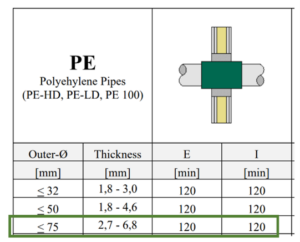
An example of a single service penetration would be a single combustible PE pipe Ø75mm going through a flexible wall. In Walraven’s case, to fire seal this pipe penetration we could recommend our Walraven Pacifyre MKII(P) fire sleeve. As you can see by reviewing the ETA documentation for this product (ETA-20/0732), an extract of which is shown here, the ETA shows that the product is approved for use in this scenario and its fire resistance would be EI 120mins.
A multiple service penetration is one that has several identical pipes that need to be fire stopped. So using the same example as above, this could be a single opening with three combustible PE pipes, all Ø75mm going through a flexible wall.
In Walraven’s case, to fire seal this multiple service penetration we could again recommend our Walraven Pacifyre MKII(P) fire sleeve. To evidence the suitability of this we can again look at the ETA. The following extract from the ETA shows you that the fire resistance in this scenario will again be EI120. (Its worth noting that in this specific example the fire resistance is the same as for a single pipe, but this may not always be the case for other pipe types and scenarios.)
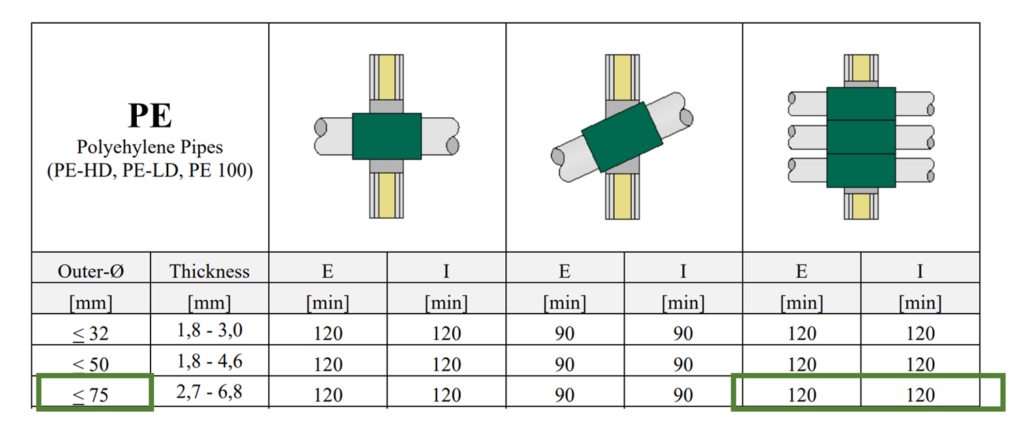
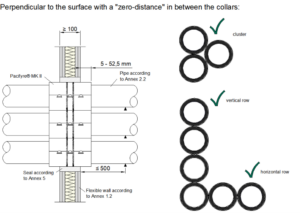 For multiple service penerations the ETA goes one step further and explains the exact service arrangements that this product has been tested for, as shown here.
For multiple service penerations the ETA goes one step further and explains the exact service arrangements that this product has been tested for, as shown here.
We can see that the Walraven Pacifyre MKII(P) fire sleeves can be used when identical pipes are installed in a cluster, vertical row and horizontal row with minimum distances between them.
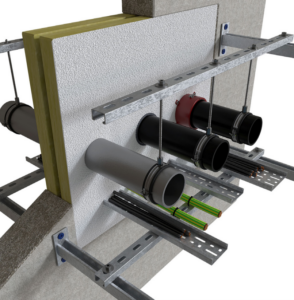 As mentioned before, this is the scenario where we have several different services or different pipe materials passing through the same opening. Naturally, this is the most challenging scenario with regards to fire stopping and careful planning, design and installation is required.
As mentioned before, this is the scenario where we have several different services or different pipe materials passing through the same opening. Naturally, this is the most challenging scenario with regards to fire stopping and careful planning, design and installation is required.
Here is an example. This photo shows a mixture of pipes (made of different materials, and different sizes), cables and cable trays going through the same opening in a concrete wall.
In this case, it is not sufficient to install individual firestop products that have been approved for use on each individual type of service. For this scenario the firestop manufacturer needs to provide a tested detail or an ETA for the whole system required for sealing the opening.
This would usually comprise of the fire batt (closing the entirety of the opening) along with all of the various individual firestop components required for each the penetrating services such as fire collars, sealants, wraps etc. All individual components must have been tested for use together in one single opening like this. Only if they have been tested together like this can they be approved for use in a mixed-service opening.
In this example the ‘system’ approval will provide us with a specific fire resistance which is usually dictated by the critical service approach (e.g. the system’s overall rating will be the same as the rating of the weakest element that would fail first in a fire test). Currently Walraven cannot offer an approved solution for mixed-service penetrations because our offering for this is still going through the required testing procedures. By the middle of 2023 we hope to be able to launch our approved solutions for mixed service openings.
It is clear to see from the above examples that mixed penetrations are by far the biggest challenge when it comes to fire stopping. Firestop solutions can only be used if they have been tested and approved for the same combination of services as a whole. Not if they have only been tested for each individual service element on their own.
So when designing the installation of M&E services it is useful to take a moment and think, can this installation of pipes and cables actually be fire stopped and is there enough test evidence for it? If in doubt you can always reach out to manufacturers or industry experts directly to ask for further advice.
Read more about fire stopping